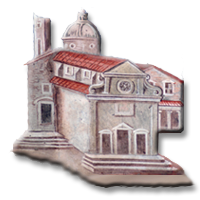|
Insediamento di riferimento
|
|
|
Collocazione di origine
|
|
|
Datazione DFT
|
|
|
Luogo di conservazione
|
Metropolitan Museum of Art, New York
|
|
Collocazione attuale
|
|
|
Provenienza
|
?Lorenzo de' Medici, Palazzo Medici, Florence (until d. 1492; inv., 1492); Hippolite, 2nd marquis de Gouvello de Kériaval, Paris; Amédée, 3rd marquis de Gouvello de Kériaval, Paris (by 1885–d. 1907); [Gimpel & Wildenstein, New York, until 1909; sold for $71,500 to Altman]; Benjamin Altman, New York (1909–d. 1913)
|
|
Dimensioni
|
34 x 50.2 cm
|
|
Materiali
|
Tempera transferred to canvas, laid down on wood, gold ground
|
|
Stemmi
|
|
|
Punzoni
|
|
|
Iscrizioni
|
|
|
Stato di conservazione
|
|
|
Info sui restauri
|
|
Non ci sono attualmente documenti a disposizione.
Posthumous inventory of the collection of Lorenzo de' Medici. 1492 [Archivio di Stato, Florence, MAP 165; published in E. Müntz, "Les Collections des Médicis au XVe siècle," 1888, vol. 1, p. 87]
, describes a painting of the Crucifixion by Fra Angelico in the Palazzo Medici, Florence, possibly this work.
Exposition de tableaux, statues et objets d'art au profit de l'oeuvre des orphelins d'Alsace-Lorraine. Exh. cat., Musée du Louvre. Paris, 1885, p. 57, no. 186, attributes it to Fra Angelico.
Bernard Berenson. Letter to Gimpel. April 21, 1910, calls it an autograph work by Fra Angelico.
Joseph Archer Crowe and Giovanni Battista Cavalcaselle. "Florentine Masters of the Fifteenth Century." A History of Painting in Italy: Umbria, Florence and Siena from the Second to the Sixteenth Century. 4, London, 1911, p. 97, states that it "may at one time have been a good example of Angelico" before it was retouched and repainted.
Bryson Burroughs. Catalogue of Paintings. 2nd ed. New York, 1916, pp. 6–7, attributes it to Fra Angelico and identifies the saints flanking the cross as (left to right) possibly Monica and Augustine, Dominic, the Virgin, Mary Magdalen, John the Evangelist, Thomas Aquinas, Francis, and Elizabeth of Hungary.
François Monod. "La galerie Altman au Metropolitan Museum de New-York (1er article)." Gazette des beaux-arts, 5th ser., 8 (September–October 1923), p. 180, attributes it to Fra Angelico and considers it a predella fragment or an oratory panel.
Frida Schottmüller. Fra Angelico da Fiesole. 2nd ed. Stuttgart, 1924, p. 268, ill. p. 243, considers it either repainted or not by Fra Angelico.
Handbook of the Benjamin Altman Collection. 2nd ed. New York, 1928, p. 42, no. 16.
Raimond van Marle. "The Renaissance Painters of Florence in the 15th Century." The Development of the Italian Schools of Painting. 10, The Hague, 1928, p. 160, fig. 99, attributes it to the school of Fra Angelico.
Bernhard Berenson. Italian Pictures of the Renaissance. Oxford, 1932, p. 22, lists it as a ruined, repainted, or restored work by Fra Angelico.
Bernhard Berenson. Pitture italiane del rinascimento. Milan, 1936, p. 19.
F. Mason Perkins. Letter. March 24, 1938, calls it a genuine but much repainted work by Fra Angelico.
Harry B. Wehle. The Metropolitan Museum of Art: A Catalogue of Italian, Spanish, and Byzantine Paintings. New York, 1940, pp. 23–24, ill., attributes it to Fra Angelico and observes that most of the heads have been restored and a blue sky painted over the original gold ground.
Art Treasures of the Metropolitan: A Selection from the European and Asiatic Collections of The Metropolitan Museum of Art. Exh. cat., The Metropolitan Museum of Art. New York, 1952, p. 223, no. 73, colorpl. 73.
John Pope-Hennessy. Fra Angelico. New York, 1952, p. 201, fig. XLV, attributes it to Fra Angelico's shop, connecting it with the pupil he calls the Master of Cell 36.
Mario Salmi. Il Beato Angelico. [Rome], 1958, pp. 87, 89, ascribes the picture to Fra Angelico and dates it between 1438 and 1446; tentatively identifies it as a work listed in the Medici inventory of 1492 [see Ref. Medici 1492].
Bernard Berenson. Italian Pictures of the Renaissance: Florentine School. London, 1963, vol. 1, p. 14.
Umberto Baldini in L'opera completa dell'Angelico. Milan, 1970, p. 108, no. 105, ill., attributes it to Fra Angelico and dates it about 1440.
Bernard Berenson. Homeless Paintings of the Renaissance. Bloomington, 1970, pp. 237, 253–54, fig. 412 (detail).
Federico Zeri with the assistance of Elizabeth E. Gardner. Italian Paintings: A Catalogue of the Collection of The Metropolitan Museum of Art, Florentine School. New York, 1971, pp. 78–79, ill., attribute it to Fra Angelico; suggest it was executed as an independent work and not part of a predella.
Burton B. Fredericksen and Federico Zeri. Census of Pre-Nineteenth-Century Italian Paintings in North American Public Collections. Cambridge, Mass., 1972, pp. 9, 293, 375, 391, 393, 397, 434, 452, 606.
John Pope-Hennessy. Fra Angelico. 2nd ed. Ithaca, N.Y., 1974, p. 229, fig. 89, says it could be a work by Fra Angelico from about 1440–45, possibly the painting recorded in the Palazzo Medici in 1492.
Howard Hibbard. The Metropolitan Museum of Art. New York, 1980, pp. 223, 232, fig. 398 (color).
Venturino Alce in "Cataloghi e indici delle opere del Beato Angelico." Beato Angelico: Miscellanea di studi. Rome, 1984, pp. 357–58, no. 105.
Umberto Baldini. Beato Angelico. Florence, 1986, p. 262, compares it to Fra Angelico's Crucifixion fresco in the Sala capitolare of the Convento di San Marco, Florence, and dates it about 1442.
John T. Spike. Angelico. Milan, 1996, p. 263, no. 136, ill., as an autograph, but greatly damaged, work by Fra Angelico; dates it about 1445.
Laurence Kanter in Fra Angelico. Exh. cat., The Metropolitan Museum of Art. New York, 2005, pp. 217–20, no. 37B, ill. (color), associates it with "The Dream of Pope Innocent III and Saints Peter and Paul Appearing to Saint Dominic" (Yale University Art Gallery, New Haven) and "Saint Dominic and His Companions Fed by Angels" (Staatsgalerie, Stuttgart), stating that all three panels originally formed part of the predella of an unidentified altarpiece.



